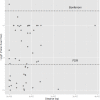Genome-Wide Association Studies of Anthracnose and Angular Leaf Spot Resistance in Common Bean (Phaseolus vulgaris L.)
- PMID: 26930078
- PMCID: PMC4773255
- DOI: 10.1371/journal.pone.0150506
Genome-Wide Association Studies of Anthracnose and Angular Leaf Spot Resistance in Common Bean (Phaseolus vulgaris L.)
Abstract
The common bean (Phaseolus vulgaris L.) is the world's most important legume for human consumption. Anthracnose (ANT; Colletotrichum lindemuthianum) and angular leaf spot (ALS; Pseudocercospora griseola) are complex diseases that cause major yield losses in common bean. Depending on the cultivar and environmental conditions, anthracnose and angular leaf spot infections can reduce crop yield drastically. This study aimed to estimate linkage disequilibrium levels and identify quantitative resistance loci (QRL) controlling resistance to both ANT and ALS diseases of 180 accessions of common bean using genome-wide association analysis. A randomized complete block design with four replicates was performed for the ANT and ALS experiments, with four plants per genotype in each replicate. Association mapping analyses were performed for ANT and ALS using a mixed linear model approach implemented in TASSEL. A total of 17 and 11 significant statistically associations involving SSRs were detected for ANT and ALS resistance loci, respectively. Using SNPs, 21 and 17 significant statistically associations were obtained for ANT and angular ALS, respectively, providing more associations with this marker. The SSR-IAC167 and PvM95 markers, both located on chromosome Pv03, and the SNP scaffold00021_89379, were associated with both diseases. The other markers were distributed across the entire common bean genome, with chromosomes Pv03 and Pv08 showing the greatest number of loci associated with ANT resistance. The chromosome Pv04 was the most saturated one, with six markers associated with ALS resistance. The telomeric region of this chromosome showed four markers located between approximately 2.5 Mb and 4.4 Mb. Our results demonstrate the great potential of genome-wide association studies to identify QRLs related to ANT and ALS in common bean. The results indicate a quantitative and complex inheritance pattern for both diseases in common bean. Our findings will contribute to more effective screening of elite germplasm to find resistance alleles for marker-assisted selection in breeding programs.
Conflict of interest statement
Figures




Similar articles
-
Co-segregation analysis and mapping of the anthracnose Co-10 and angular leaf spot Phg-ON disease-resistance genes in the common bean cultivar Ouro Negro.Theor Appl Genet. 2013 Sep;126(9):2245-55. doi: 10.1007/s00122-013-2131-8. Epub 2013 Jun 13. Theor Appl Genet. 2013. PMID: 23760652
-
Fine-mapping of a major QTL controlling angular leaf spot resistance in common bean (Phaseolus vulgaris L.).Theor Appl Genet. 2015 May;128(5):813-26. doi: 10.1007/s00122-015-2472-6. Epub 2015 Mar 5. Theor Appl Genet. 2015. PMID: 25740562 Free PMC article.
-
New Andean source of resistance to anthracnose and angular leaf spot: Fine-mapping of disease-resistance genes in California Dark Red Kidney common bean cultivar.PLoS One. 2020 Jun 29;15(6):e0235215. doi: 10.1371/journal.pone.0235215. eCollection 2020. PLoS One. 2020. PMID: 32598372 Free PMC article.
-
Development of molecular markers linked to disease resistance genes in common bean based on whole genome sequence.Plant Sci. 2016 Jan;242:351-357. doi: 10.1016/j.plantsci.2015.09.006. Epub 2015 Sep 9. Plant Sci. 2016. PMID: 26566851 Review.
-
A Review of Angular Leaf Spot Resistance in Common Bean.Crop Sci. 2019 Jul-Aug;59(4):1376-1391. doi: 10.2135/cropsci2018.09.0596. Epub 2019 Jun 4. Crop Sci. 2019. PMID: 33343018 Free PMC article. Review.
Cited by
-
Characterization of fungal pathogens and germplasm screening for disease resistance in the main production area of the common bean in Argentina.Front Plant Sci. 2022 Sep 7;13:986247. doi: 10.3389/fpls.2022.986247. eCollection 2022. Front Plant Sci. 2022. PMID: 36161011 Free PMC article. Review.
-
The Kirkhouse Trust: Successes and Challenges in Twenty Years of Supporting Independent, Contemporary Grain Legume Breeding Projects in India and African Countries.Plants (Basel). 2024 Jul 1;13(13):1818. doi: 10.3390/plants13131818. Plants (Basel). 2024. PMID: 38999658 Free PMC article. Review.
-
Genome-wide meta-QTL analyses provide novel insight into disease resistance repertoires in common bean.BMC Genomics. 2022 Oct 3;23(1):680. doi: 10.1186/s12864-022-08914-w. BMC Genomics. 2022. PMID: 36192697 Free PMC article.
-
Genetic Augmentation of Legume Crops Using Genomic Resources and Genotyping Platforms for Nutritional Food Security.Plants (Basel). 2022 Jul 18;11(14):1866. doi: 10.3390/plants11141866. Plants (Basel). 2022. PMID: 35890499 Free PMC article. Review.
-
Genome Wide Association Mapping of Root Traits in the Andean Genepool of Common Bean (Phaseolus vulgaris L.) Grown With and Without Aluminum Toxicity.Front Plant Sci. 2021 Jun 25;12:628687. doi: 10.3389/fpls.2021.628687. eCollection 2021. Front Plant Sci. 2021. PMID: 34249030 Free PMC article.
References
-
- Broughton WJ, Hernández G, Blair MW, Beebe S (2003) Beans (Phaseolus spp.)–model food legumes. Plant Soil 252: 55–128. 10.1023/A:1024146710611 - DOI
-
- Gepts P, Aragão FJL, de Barros E, Blair MW, Brondani R, Broughton W (2008) Phaseolus beans, a major source of dietary protein and micronutrients. In: Moore PH, Ming R (eds) Genomics of tropical crop molecular markers linked to angular leaf spot resistance genes in common beans accessions G10909. Mol Breed 28: 57–71.
-
- Azarpazhooh E, Boye JI (2012) "Dry bean composition and effect of processing on protein, carbohydrates, fiber and minor constituents.",—Common Beans and Pulses: Production, Processing, and Nutrition, John Wiley & Sons, Ltd., 2012.
-
- Pastor-Corrales MA, Tu JC (1989) Anthracnose. p. 77–104. In Pastor-Corrales MA, Schwartz HH (ed.) Bean production problems in the tropics. 2nd ed. CIAT, Cali, Colombia.
Publication types
MeSH terms
Substances
LinkOut - more resources
Full Text Sources
Other Literature Sources
Miscellaneous

